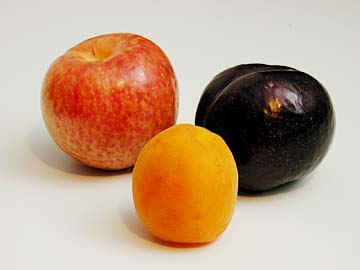

Key Ingredient

SUPERMARKET AISLES are now bursting with plums. There are literally hundreds of varieties of plums cultivated throughout the world, from green Kelsey plums to red-fleshed Santa Rosas. Pluot
One variety that has popped up in recent years is a hybrid called the pluot. The fruit is very plump and juicy, and generally sweeter than more common red or black plums.
The basics: The pluot is the result of an agricultural term called interspecific hybrids. It is a complex cross between two fruits, the plum and apricot. The pluot has predominantly plum parentage, about 75 percent, and 25 percent apricot parentage. Thus, the pluot has the general appearance of a plum with a round, plump shape and smooth skin.
Another interspecific hybrid called the aprium is more predominantly apricot and resembles the apricot in flavor with a fuzzy skin. The two fruits were developed by Zaiger Genetics in Modesto, Calif.
Selecting: Pluots themselves come in several varieties, ranging from a dark purple variety with red flesh to the more popular light-skinned speckled variety called Dapple Dandy or Dinosaur Egg. The fruit resembles a giant jawbreaker. The flesh of the Dapple Dandy is also a neat shade of light pink to white.
Look for fruit that is firm but gives slightly to the touch. Watch for soft spots and cracks in the skin.
Storing: Pluots, like plums, often need additional ripening at home after purchase. Store in a paper bag for a couple of days until the fruit emits a plumy aroma and gives slightly when pressed. Then store fruit in a plastic bag in the refrigerator for three to five days.
Use: Like plums, pluots can be used in a number of sweet and savory recipes, but should ultimately be savored in and of themselves. Because Dapple Dandys have a unique look, try adding slices to jazz up a fruit salad or a salad of mixed baby greens and a citrus vinaigrette.
Where to buy: Pluots are in peak season and should be available in most supermarkets. They are a bit expensive at $2.69 to $3.69 a pound but are worth every penny.
Food Stuffs: Morsels
Contact Eleanor Nakama-Mitsunaga
online through features@starbulletin.com